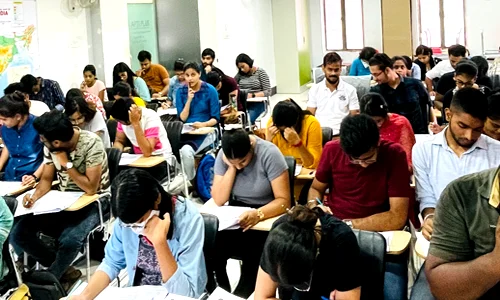



Neurotechnology—ranging from brain-computer interfaces to neural stimulation—offers India major gains in health, innovation, and economic growth by improving treatment for neurological disorders, enabling assistive devices, and creating new tech industries. Globally, countries like the U.S., China, and Chile are advancing neurotech while shaping ethical norms and neurorights. However, its promise depends on strong regulation that safeguards mental privacy, autonomy, equity, and long-term safety. If India builds research capacity, industry linkages, and ethical oversight,
Click to View MorePollution is emerging as a hidden reproductive health crisis, as toxins in air, water, soil and plastics disrupt hormones, damage sperm and egg quality, and increase miscarriage and poor birth outcomes. Evidence from India and globally shows declining fertility, particularly in polluted cities, indicating that cleaner environments are essential for protecting family health and demographic stability.
Click to View MoreIndia’s post-Independence economic journey moved from slow, state-led growth to market-driven expansion. The phrase “Hindu rate of growth,” coined by economist Raj Krishna, described India’s stagnant average growth of roughly three to three-and-a-half percent between the nineteen fifties and seventies. However, growth began accelerating from the early nineteen eighties, well before the nineteen ninety-one reforms, as selective liberalisation and industrial capacity building improved productivity. The reform wave of nineteen ninety-one deepened this shift, while the two thousand three to two thousand eleven phase delivered high growth of eight to nine percent. Since then, India has faced moderation linked to global headwinds, financial stress and the pandemic, yet it remains the fastest growing major economy. Thus, India has long surpassed the so-called Hindu rate of growth, evolving from a low-growth economy to one increasingly driven by reform, capability building and structural transformation.
Click to View MoreA weaker rupee may boost export prices in the short run, but India’s long-term trade gains depend more on productivity, innovation, infrastructure and skilled labour. While depreciation can temporarily ease the trade gap, it also raises import costs, fuels inflation and risks capital flight in an import-dependent economy. Sustainable competitiveness therefore lies in strengthening real economic capabilities, supported by targeted policy measures such as incentives for exporters, attracting dollar inflows and stabilising forex markets.
Click to View MoreIndia’s pension system is evolving from a limited government-backed entitlement framework to a broader, contributory, and market-linked architecture. While schemes like NPS, APY, PM-SYM and digital reforms have widened access and increased assets to over ₹16 lakh crore, coverage remains uneven—especially for informal workers, who form the majority of the labour force. Key challenges persist in pension adequacy, fiscal sustainability, and public awareness. Strengthening inclusion, improving returns, and building trust are central to shaping a more secure retirement landscape for India’s ageing population.
Click to View MoreThe WHO’s first guideline on GLP-1 therapy marks a major shift in treating obesity as a chronic disease rather than a behavioural issue. It conditionally recommends drugs like semaglutide and tirzepatide for adults with obesity, but only alongside diet, exercise, and counselling. While the therapy shows significant weight loss and metabolic benefits, WHO warns of high costs, limited access, safety gaps, and the need for strong health systems to ensure equitable, long-term care.
Click to View MoreWorld Soil Day, observed on 5 December, highlights soil’s vital role in sustaining food systems, climate stability, water regulation and biodiversity. With nearly one-third of global soils degraded and India facing significant land decline, the day underscores the need for scientific soil management, grassland restoration, and farmer-led stewardship. It serves as a reminder that soil is a living resource requiring urgent protection to secure livelihoods, ecological health and long-term sustainability.
Click to View MoreIndia entered 2025 aiming to eliminate TB but remains far from the goal. Despite free treatment and programme reforms, India still accounts for over a quarter of global cases due to stigma, underinvestment, private sector dependence, weak awareness and poor prevention. Politically prioritising TB, integrating socio-economic determinants and strengthening surveillance are key to moving from intent to impact.
Click to View MoreThe Health Security se National Security cess seeks to tax machines used in pan masala and tobacco production to generate revenue and discourage consumption. While this approach simplifies administration in a fragmented industry, it raises concerns about evasion, informalisation, and weak linkage to public health outcomes. Without strong enforcement and complementary measures, the cess risks functioning more as a fiscal tool than an effective tobacco control or health policy instrument.
Click to View More
The RBI’s 25 bps repo rate cut to 5.25% reflects confidence in low inflation and strong growth, aiming to boost borrowing, investment and consumption through cheaper credit. While it supports economic momentum, risks persist due to rupee weakness and uncertain external conditions, making cautious monetary calibration essential.
Click to View MoreFirst Indian study measuring inhalable microplastics at breathing height across four metros shows plastics now form up to 5% of urban particulate pollution. Markets in Kolkata and Delhi show highest loads. iMPs carry pathogens, heavy metals and toxic chemicals, posing emerging health risks including inflammation, hormonal disruption and possible cancer pathways. Urgent inclusion of microplastics in air-quality regulation is needed.
Click to View MoreThe revival of the Shipping Corporation of India marks a strategic shift in India’s maritime policy as the government seeks to rebuild national shipping capacity after decades of decline caused by liberalisation, ageing fleets and loss of preferential rights. The pandemic and global supply-chain disruptions exposed India’s dependence on foreign carriers, highlighting the need for stronger domestic control over EXIM logistics, energy transport and critical shipping routes. By acquiring new vessels through PSU joint ventures and aligning with global trends of increased state ownership in strategic sectors, India aims to enhance economic resilience, safeguard national interests and re-establish a robust maritime presence.
Click to View More
© 2025 iasgyan. All right reserved